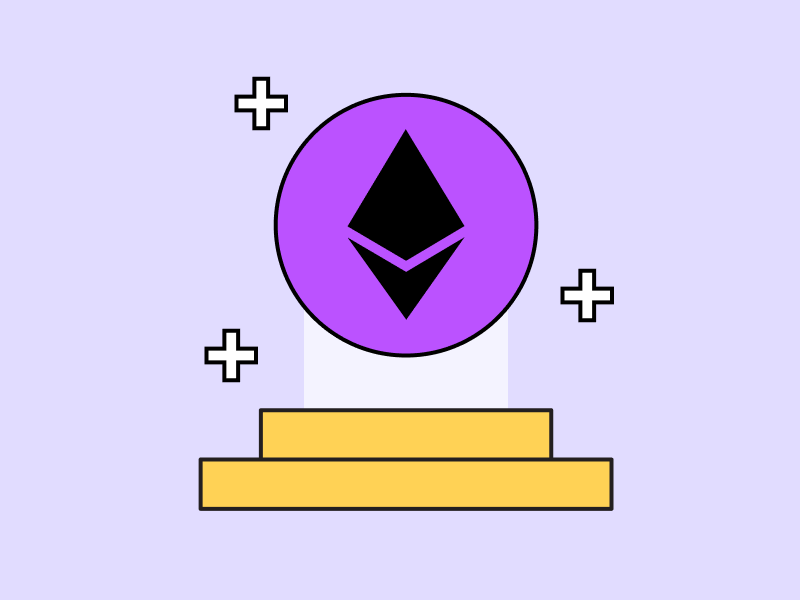The Ethereum Pectra upgrade is a major update designed to improve the performance, efficiency, and overall user experience of the Ethereum network. Through a series of technical enhancements across multiple system layers, Pectra introduces new features relevant to users, developers, and investors alike. This upgrade also marks another important step in Ethereum’s long-term vision of building a more scalable, secure, and user-friendly blockchain ecosystem.
So, what exactly is the Ethereum Pectra upgrade? What are its key features? When will it be released, and how might it impact the price of ETH? Read on for a complete breakdown.
Article Summary
💡 Pectra is a major Ethereum upgrade that includes improvements to both the execution layer (Prague) and the consensus layer (Electra).
⚙️ It builds on the previous Dencun upgrade, introducing features like EIP-7702, which allows EOAs to temporarily run smart contract logic—a key step toward account abstraction.
🗓️ On April 3, 2025, Ethereum core developers officially set May 7, 2025, as the target release date for Pectra, following a successful final test on the Hoodi testnet.
💻 Pectra includes 11 major code changes, known as Ethereum Improvement Proposals (EIPs), all of which will be launched simultaneously in one upgrade.
📈 The Pectra upgrade is seen as a potential positive catalyst thanks to features like staking optimization, performance improvements, and support for more user-friendly wallets. While the market remains bearish, some analysts are optimistic that ETH could reach $10,000 by the end of 2025.
What is the Ethereum Pectra Upgrade?
Pectra is the next major upgrade in the Ethereum ecosystem, bringing a series of important enhancements to the network’s two main components: the execution layer and the consensus layer.
This upgrade combines two significant hard forks: Prague for the execution layer and Electra for the consensus layer. Its main objectives include improving scalability, enhancing network security, optimizing staking processes, and providing better tools for developers.
Pectra is currently being tested on various Ethereum testnets. The first round of testing began on the Holesky testnet in February 2025, and further testing is scheduled for the Sepolia testnet in March.
Why Is the Pectra Upgrade Important?
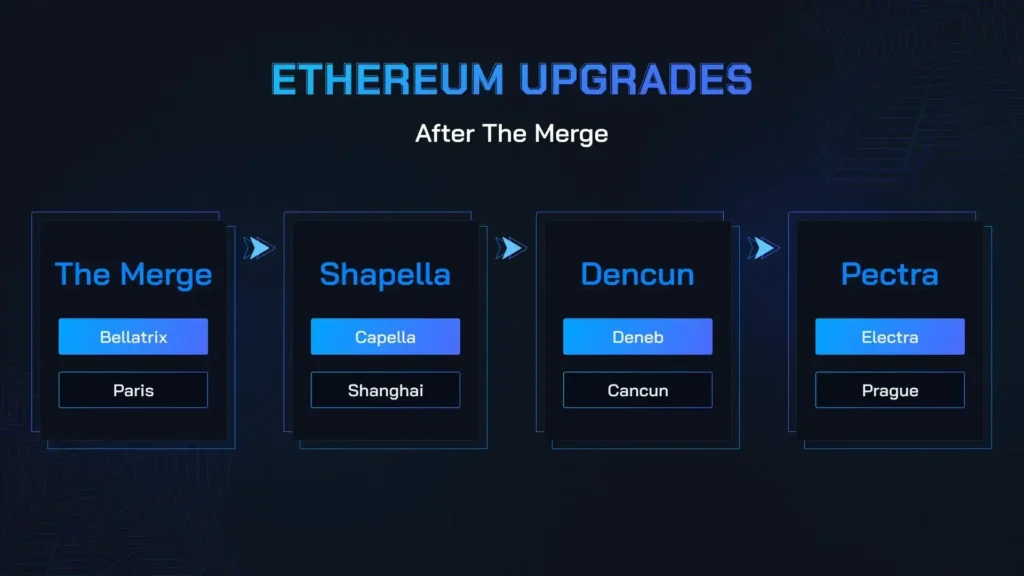
Before diving into the technical details, it’s important to understand the background and reasoning behind developing the Pectra upgrade.
Pectra builds upon the previous major update, Dencun, which introduced blob transactions (EIP-4844) to support the growth of rollup solutions and enhance Ethereum’s overall scalability.
While scalability is a key priority, it is not Ethereum’s only long-term goal. One of the broader visions is to create a simpler and more seamless user experience, particularly through account abstraction.
This idea aims to make crypto wallets smarter and more flexible. The journey began with EIP-4337, which enabled using smart wallets without requiring changes to Ethereum’s core protocol.
Pectra continues this progression by introducing EIP-7702, which allows EOAs (Externally Owned Accounts)—such as standard Ethereum wallets—to temporarily execute smart contract logic during a transaction, bringing Ethereum closer to full account abstraction.
When Will the Ethereum Pectra Upgrade Launch?
On Thursday, April 3, 2025, Ethereum core developers officially announced May 7, 2025, as the target date for the highly anticipated Pectra upgrade. This marks the beginning of a major phase of transformation for the network—the most significant upgrade since March 2024.
The decision was made during a virtual meeting between Ethereum’s core development team shortly after a successful final test run of Pectra on the Hoodi testnet.
Hoodi served as the third and final simulation before mainnet deployment. Previous testnet runs encountered bugs, which led developers to postpone the mainnet release until the issues were resolved.
What are the new features of the Ethereum Pectra Upgrade?
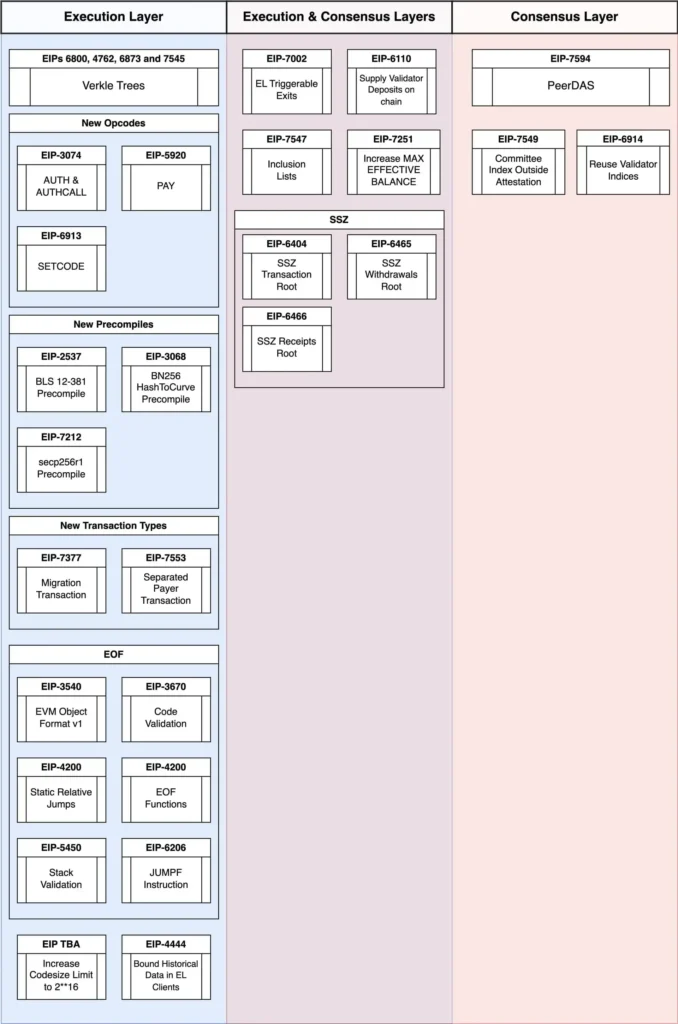
The Pectra upgrade introduces 11 major code changes, known as Ethereum Improvement Proposals (EIPs), which will be deployed together in a single update. To make the scope of these proposals easier to understand, Ethereum has grouped the EIPs into categories based on their primary focus.
1. Validator and Staking Improvements
This group of EIPs is designed to simplify and enhance the efficiency of the staking process and improve how validators interact with the network.
- EIP-7251: Increase in Maximum Effective Staking Balance
Previously, each Ethereum validator could stake a maximum of 32 ETH, which limited flexibility and operational efficiency. EIP-7251 addresses this issue by raising the maximum effective balance per validator to 2,048 ETH.
Under this new structure, smaller stakers still earn additional rewards for excess ETH, while larger operators can consolidate their assets into fewer validators. As a result, the total number of validators on the network can be reduced, decreasing the number of signatures processed per epoch and improving the overall efficiency of Ethereum’s consensus mechanism.
- EIP-7002: Execution Layer-Triggered Validator Exits
EIP-7002 proposes adding a smart contract within the Execution Layer that allows stakers to initiate a validator exit using only their withdrawal key without requiring access to the validator’s active key.
Previously, exits could only be initiated by the holder of the validator key (BLS key), which posed a problem if that key was lost or managed by someone else. With this EIP, stakers can simply call a function in the smart contract to exit, making the process more secure, user-friendly, and independent from the Beacon Chain or validator key access.
- EIP-6110: Validator Deposit Processing via the Execution Layer
EIP-6110 aims to simplify and accelerate the validator deposit process by moving it directly to the Execution Layer. Previously, deposits relied on a voting mechanism in the Consensus Layer, which could take up to 12 hours, depended on external data, and introduced inconsistencies between client implementations.
With this EIP, validator deposits are recorded directly in the block structure of the Execution Layer. This significantly speeds up validator activation, reducing the wait time to approximately 13 minutes, and lowers the complexity of client software.
- EIP-7685: Standardized Communication Between Layers
EIP-7685 proposes a unified framework to standardize communication between the Execution Layer and the Consensus Layer, which previously lacked a consistent method. The absence of standardization has made key processes—such as deposits, withdrawals, and validator consolidation—less efficient.
Introducing this EIP enables more consistent and effective handling of inter-layer requests. It also enables smart contracts to interact directly with the Consensus Layer, unlocking new possibilities and improving flexibility across the Ethereum ecosystem.
- EIP-7549: Moving the Committee Index Outside the Attestation Structure
EIP-7549 proposes removing the committee index from attestation messages signed by validators when casting votes on the Ethereum network. This change reduces the number of BLS signatures required to verify all votes in a single epoch by up to 64 times, significantly improving validation efficiency.
Additionally, this EIP enables more efficient storage of attestation data within blocks. Previously, a block could only store votes from two slots; with this proposal, it can now hold up to eight slots’ worth of votes, without increasing the block size. This means that even if only a few proposers are online (e.g., 1 out of 8), all votes can still be efficiently included on-chain.
2. Data Efficiency and Blob Adoption
This group of EIPs focuses on improving data storage efficiency by promoting the use of blobs as a more effective alternative to calldata.
- EIP-7623: Calldata Cost Adjustment
EIP-7623 aims to encourage full adoption of blobs by increasing the cost of using calldata, which is still frequently used by some Layer 2 solutions due to its occasionally lower cost, despite being less efficient.
By adjusting the cost structure, developers and users are expected to transition toward blobs as a more optimized method of data storage. This shift will lead to more efficient use of network storage, reduced transaction fees, and overall improvements in Ethereum’s performance and scalability.
- EIP-7691: Increasing Blob Capacity
EIP-7691 proposes increasing blob capacity to accommodate the rapid growth of rollup usage. The current blob limits are considered too conservative and could hinder the network’s scalability.
The proposal raises the target number of blobs per block from 3 to 6 and increases the maximum from 6 to 9. This allows more rollup data to be processed in each block, expanding network capacity, lowering transaction costs, and enhancing overall efficiency and scalability on Ethereum.
- EIP-7840: Blob Scheduling via Client Configuration
EIP-7840 seeks to simplify the traditionally complex process of adjusting blob parameters by introducing a configuration mechanism directly within the client setup files.
This system allows developers and node operators to easily set parameters such as target blobs per block, maximum blob limits, and the base fee update fraction for each fork.
This approach not only streamlines network management but also contributes to a more stable and predictable blob fee market, supporting the long-term efficiency and sustainability of blob usage within the Ethereum ecosystem.
3. Cryptographic Operations Optimization
- EIP-2537: Precompile for BLS12-381 Curve Operations
EIP-2537 proposes adding a native precompile for operations on the BLS12-381 curve, aiming to address the high gas costs associated with verifying BLS signatures and zkSNARK proofs within smart contracts.
With this precompile, cryptographic processes that were previously expensive and complex can be executed much more efficiently.
As a result, gas fees can be significantly reduced, and the verification of multi-signatures and zk-proofs becomes faster and simpler—an important advancement for privacy—and security-focused applications in the Ethereum ecosystem.
4. Expanded Access to Historical Data
- EIP-2935: Storage of Historical Block Hashes
EIP-2935 proposes storing up to 8,192 recent block hashes (approximately 27 hours’ worth) in a system contract, as a solution to the limitations of the current Blockhash opcode, which can only access the last 256 blocks (about 51 minutes).
While the opcode’s existing behavior remains unchanged, the addition of this historical data allows smart contracts and cross-chain applications to retrieve older block information directly from the blockchain.
This reduces the reliance on external data sources and improves the reliability and integrity of data across various Ethereum-based applications.
5. Smart Accounts and Account Abstraction
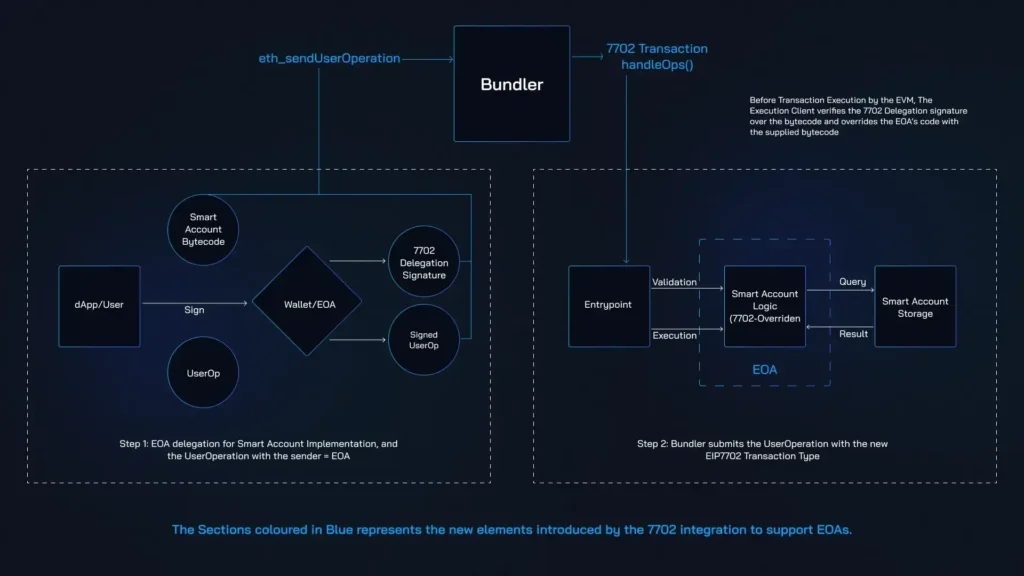
- EIP-7702: Enabling Execution Capabilities for EOAs
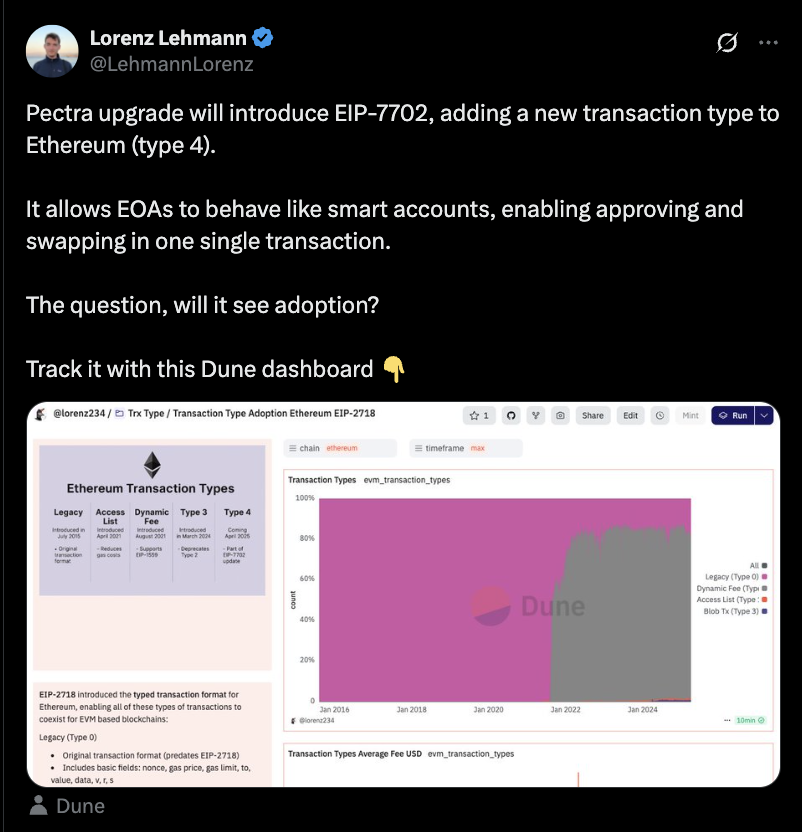
EIP-7702 proposes a new transaction type that allows Externally Owned Accounts (EOAs) to temporarily execute smart contract code during a transaction. This addresses the long-standing limitation of EOAs, which have traditionally been restricted to signing transactions without the ability to perform logic execution.
With this feature, EOAs can support advanced functionalities such as transaction batching, gas sponsorship by third parties, and alternative authentication methods.
This proposal represents a key step toward full account abstraction, which aims to enhance user flexibility, security, and convenience when interacting with the Ethereum network.
Potential Impact of the Ethereum Pectra Upgrade
Ethereum is currently facing a challenging period, with notable price declines. According to market data from Pintu, the price of Ethereum (ETH) dropped by 2.94% over the past week (from March 30 to April 6, 2025). Over a one-month span, from March 7 to April 6, 2025, the decline was even more significant, reaching 18.46%.

Looking back at previous Ethereum upgrades offers some optimism. For example, during the Shapella upgrade in 2023, despite initial concerns of massive sell-offs, ETH prices remained stable and eventually began to rise gradually.
📚 Learn more about the Ethereum Shapella upgrade on Pintu Academy.
Several features in the Pectra upgrade can potentially support a price recovery. Staking optimizations could attract institutional investors and reduce the circulating ETH supply. At the same time, more user-friendly wallets may encourage broader adoption, while performance enhancements are expected to appeal to developers and Layer-2 users alike.

Expert opinions remain divided. On platform X, @ItoShimotsuma has highlighted promising technical signals, including an accumulation of sell positions that could hint at a potential price reversal.

A more optimistic view comes from @CryptoElites, who predicts ETH could reach $10,000 by the end of 2025, driven by Ethereum’s strengthening fundamentals.
Conclusion
The Pectra upgrade represents a major milestone for Ethereum, delivering key enhancements across the execution layer (Prague) and consensus layer (Electra). With 11 core EIPs—including EIP-7702, which supports account abstraction—Pectra is designed to improve scalability, staking efficiency, and overall user experience. Following a successful final test on the Hoodi testnet, the official main net launch is scheduled for May 7, 2025, signaling the network’s readiness for a new era of transformation.
Despite the current bearish trend in the crypto market, many view Pectra as a potential positive catalyst for ETH. Its new features—from better wallet usability to improved network performance—could attract investors and developers. Some analysts even forecast that ETH may reach $10,000 by the end of 2025, supported by increased adoption and growing confidence in Ethereum’s evolving fundamentals.
How to Buy Crypto Assets on Pintu
Interested in investing in crypto assets? Don’t worry—through Pintu, you can easily buy various crypto assets like BTC, ETH, and many others without the fear of scams. All crypto assets available on Pintu have gone through a strict evaluation process that prioritizes caution and security.
The Pintu app is also compatible with popular digital wallets such as MetaMask, making your transactions even more convenient. Go ahead and download the Pintu app on the Play Store or App Store today! Your security is guaranteed, as Pintu is regulated and supervised by Bappebti and Kominfo.
In addition to trading, Pintu also allows you to learn more about crypto through a wide range of articles on Pintu Academy, updated weekly!
All articles from Pintu Academy are intended for educational purposes only and do not constitute financial advice.
References:
- Consensys. Understanding Ethereum’s Pectra Upgrade. Accessed on April 3, 2025.
- Coindesk. Ethereum Developers Lock in May 7 for Pectra Upgrade. Accessed on April 6, 2025.
- Ethereum Foundation Blog. Pectra Testnet Announcement. Accessed on April 6, 2025.
- Investx. Ethereum: Will the Upcoming Pectra Update Boost ETH Price? Accessed on April 6, 2025.
- QuickNode. Ethereum Pectra Upgrade: Key Improvements and Impact. Accessed on April 3, 2025.
- Quill Audits. How Ethereum Pectra Upgrade is Going to Supercharge Ethereum. Accessed on April 6, 2025.
